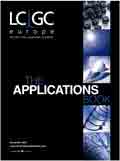High Speed Analysis of Paracetamol and its Process Impurities
KNAUER Application Note
Anke Knöfel and Silvia Marten, KNAUER, Berlin, Germany.
Paracetamol is a major ingredient in numerous medications due to its analgesic and antipyretic properties. During its synthesis (Figure 1), a total of ten process-related impurities are observed. Several HPLC applications have been developed for the monitoring of these impurities,1,2 including the European Pharmacopoeia which has adopted an isocratic HPLC method using a silica-based C8 column with 5 μm particle size, requiring a run time of 45 min.3 By using a gradient method and standard HPLC instrumentation, the analysis can be reduced to 7 min.4

Figure 1: Synthesis of paracetamol (N-(4-hydroxyphenyl)acetamide).
To remain competitive however, pharmaceutical laboratories require even faster methods with higher efficiency and rapid resolution. These priorities have led to the development of stable sub-2 μm columns which can meet these demands. Compared to 5 μm columns, sub-2 μm columns offer shorter analysis times, improvements in resolution, sensitivity and peak capacity. This study describes a gradient method using a sub-2 μm column for the simultaneous determination of nine impurities and one degradation product.
Experimental
The analysis was performed on a KNAUER high pressure gradient PLATINblue UHPLC system, equipped with two P-1 Pumps, M-1 Degasser, AS-1 Autosampler, T-1 Column Temperature Manager and UV-1 Detector.
Column: BlueOrchid 120 C18, 100 × 2 mm, 1.8 μm
Mobile phase: A: ACN / B: Buffer (pH 3.7)
Gradient:
Time (min)……% A……% B
0.00……............13……...87
0.30……............13……...87
2.00……............70……...30
2.50……............70……...30
Flow rate: 0.8 mL/min
Detection: UV at 245 nm (80 Hz, 0.005 s)
Temperature: 50 °C
Injection volume: 1 μL
Results
Using a KNAUER PLATINblue UHPLC system and a BlueOrchid C18 1.8 μm column, paracetamol and ten impurities were separated in under 2 min (Figure 2), more than 3× faster than the conventional HPLC gradient method.4 Moreover, the UHPLC method required only one-fifth of the sample volume and eluent consumption was reduced by 18%.

Figure 2: High speed separation of paracetamol mixture on BlueOrchid 120 C18, 1.8 μm, 100 Ã 2 mm (blue: standard; red: pharmaceutical formulation). 1. 4-aminophenol; 2. paracetamol (N-(4-hydroxyphenyl) acetamide); 3. N-(4-hydroxyphenyl) propanamide; 4. N-(2-hydroxyphenyl) acetamide; 5. N-(3-chloro-4-hydroxyphenyl) acetamide; 6. 1-(4-hydroxyphenyl) ethanone oxime; 7. N-phenylacetamide; 8. 4-(acetylamino) phenyl acetate; 9. 4-nitrophenol; 10. chloroacetanilide; 11. 1-(2-hydroxyphenyl) ethanone.
The limit of detection (LOD) for all compounds was in the range of 0.01–0.08 μg/mL. Retention time reproducibility of the UHPLC method was in the range of 0.1–0.7% RSD (n = 5).
Conclusion
The high speed analysis of paracetamol and its related process impurities in a pharmaceutical formulation illustrates how analytical labs can benefit from sub-2 μm columns like BlueOrchid in combination with a UHPLC system like PLATINblue, in terms of faster separations, higher resolution, higher sensitivity and reduced mobile phase consumption.
References
1. R.R. Nageswara and A. Narasaraju, Anal. Sci., 22, 287–292 (2006).
2. B.S. Nageralli et al., J. Chromatogr. B, 798(1), 49-54 (2003)
3. European Pharmacopoeia Monograph, Paracetamol 01/2005:0049/2.2.29
4. Knauer, Applications Journal, V7801, 07/2008, 79, www.knauer.net

Knauer GmbH
Hegauer Weg 38, 14163 Berlin, Germany
tel. +49 30 809727 0 fax: +49 30 801501 0
E-mail: info@knauer.net
Website: www.knauer.net

AOAC International Awarded NIST Grant for Developing Drug Testing Standards
October 31st 2024The grant will be part of a new collaborative scientific initiative to address the need for standards that define the desired performance of lateral flow immunoassay test strips to detect illicit drugs in tablets and powders.
Characterization of Product Related Variants in Therapeutic mAbs
October 15th 2024Navin Rauniyar and Xuemei Han of Tanvex Biopharma USA recently discussed how identifying product-related variants through characterization enables the recognition of impurities that compromise the quality and safety of drugs.